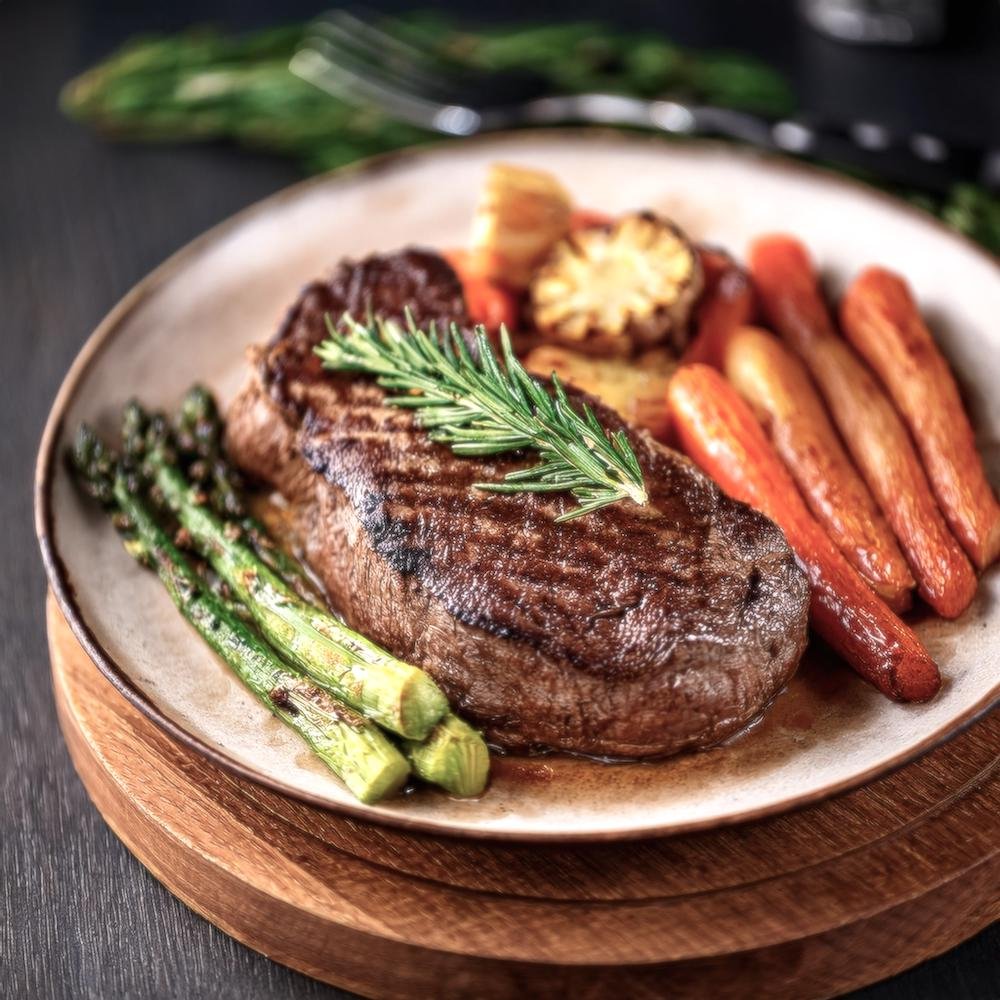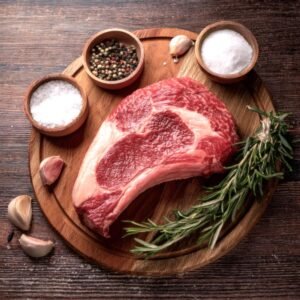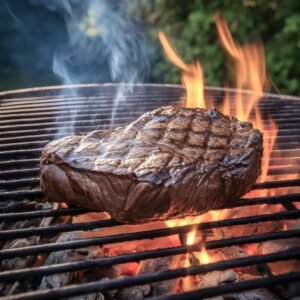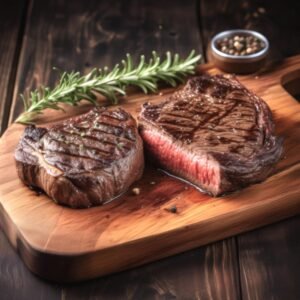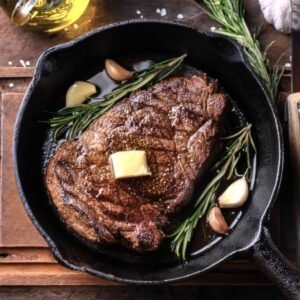Beef chuck eye steak is a hidden gem for steak lovers, often referred to as the “poor man’s ribeye” due to its similar flavor and texture at a fraction of the price. Cut from the shoulder region of the cow, this steak delivers a rich, beefy taste and satisfying tenderness, making it a favorite for grilling, pan-searing, or broiling.
While ribeye is known for its premium quality and high cost, chuck eye steak offers an affordable alternative that doesn’t compromise on flavor. Whether you’re cooking for a weeknight dinner or a backyard barbecue, this versatile cut of meat is perfect for satisfying your steak cravings without breaking the bank.
In this guide, we’ll dive into everything you need to know about chuck eye steak, from its origin and flavor profile to the best cooking techniques for maximizing its potential.
What Is Beef Chuck Eye Steak?
Beef chuck eye steak comes from the shoulder section of the cow, also known as the chuck primal cut.
Location on the Cow
- The Chuck Cut:
- Chuck eye steak is taken from the upper shoulder area, right next to the rib primal.
- This proximity to the rib section is why it shares many characteristics with ribeye steak.
- Similar to Ribeye:
- Only a few chuck eye steaks can be cut from each cow, making it a rare find compared to other chuck cuts.
- It’s essentially an extension of the ribeye muscle, with slightly less marbling but comparable flavor.
How It Compares to Ribeye
- Marbling:
- Ribeye tends to have more marbling, resulting in a slightly richer flavor and increased tenderness.
- Chuck eye steak has moderate marbling, delivering a robust beefy taste.
- Price Difference:
- Chuck eye steak is significantly more affordable than ribeye, making it an excellent choice for budget-conscious steak lovers.
- Availability:
- Chuck eye steak can be harder to find in grocery stores due to its limited quantity per cow, but many butchers carry it upon request.
Flavor Profile and Texture
Beef chuck eye steak is prized for its rich, beefy flavor and its ability to mimic the tenderness of a ribeye when cooked properly. Here’s a closer look at what makes this cut stand out:
Rich, Beefy Flavor
- Bold Taste:
- Thanks to its proximity to the ribeye, chuck eye steak boasts a robust, beef-forward flavor that satisfies steak enthusiasts.
- It’s ideal for those who enjoy deep, savory meat flavors without needing excessive seasoning.
- Versatility:
- The natural flavor of chuck eye steak pairs well with a variety of marinades, rubs, and sauces, making it adaptable to different cuisines.
Pro Tip: A simple seasoning of salt, pepper, and garlic enhances the natural flavor without overpowering it.
Tenderness and Marbling
- Moderate Marbling:
- While it has slightly less marbling than a ribeye, the fat content in chuck eye steak is sufficient to keep it juicy and tender when cooked correctly.
- Texture:
- The texture is firm but tender, with a pleasant chewiness that makes it satisfying without being tough.
- Cooking Enhancements:
- Proper cooking techniques, such as high-heat searing or grilling, can help render the fat and enhance the steak’s overall tenderness.
Pro Tip: Let the steak rest for 5–10 minutes after cooking to allow the juices to redistribute, ensuring each bite is moist and flavorful.
Best Pairings
- Side Dishes:
- Serve chuck eye steak with mashed potatoes, roasted vegetables, or a fresh salad for a complete meal.
- Wines and Beverages:
- Pair with bold red wines like Cabernet Sauvignon or Malbec to complement the steak’s rich flavor.
Pro Tip: Top the steak with a pat of herb butter for added richness and a gourmet touch.
Cooking Methods for Beef Chuck Eye Steak
Cooking beef chuck eye steak to perfection requires proper techniques to bring out its rich flavor and tender texture. Whether you prefer grilling, pan-searing, or broiling, the key is to use high heat to sear the steak while maintaining its juiciness.
Grilling
- Why It Works:
- Grilling enhances the natural smokiness of the steak and creates a delicious crust from the high heat.
- Steps:
- Preheat your grill to medium-high heat (about 400–450°F).
- Season the steak generously with salt, pepper, and garlic powder or your favorite dry rub.
- Place the steak on the grill and cook for 4–5 minutes per side for medium-rare (internal temperature of 135°F).
- Let the steak rest for 5–10 minutes before serving.
Pro Tip: Add a light brush of olive oil or melted butter to the steak before grilling for extra juiciness and flavor.
Pan-Searing
- Why It Works:
- Pan-searing provides a beautiful golden-brown crust while allowing for precise control over the cooking process.
- Steps:
- Heat a cast-iron skillet or heavy-bottomed pan over medium-high heat. Add 1–2 tablespoons of oil with a high smoke point, such as canola or avocado oil.
- Pat the steak dry with paper towels and season both sides generously.
- Sear the steak for 3–4 minutes on each side until a crust forms.
- Reduce the heat to medium and add butter, garlic, and fresh herbs like rosemary or thyme to the pan. Spoon the melted butter over the steak (basting) for additional flavor.
- Remove the steak when it reaches an internal temperature of 135°F for medium-rare.
Pro Tip: Use a meat thermometer to avoid overcooking, as chuck eye steak can dry out if cooked past medium.
Broiling
- Why It Works:
- Broiling delivers high, direct heat similar to grilling, perfect for achieving a crisp exterior.
- Steps:
- Preheat your oven’s broiler and place the oven rack about 6 inches from the heat source.
- Season the steak and place it on a broiler-safe pan or a wire rack over a baking sheet.
- Broil the steak for 4–5 minutes per side, flipping halfway through, until the desired doneness is reached.
- Let the steak rest for a few minutes before slicing.
Pro Tip: For extra caramelization, sprinkle a touch of brown sugar or brush the steak with a glaze before broiling.
Sous Vide (Optional)
- Why It Works:
- Sous vide cooking ensures perfect doneness and maximum tenderness by cooking the steak at a controlled temperature.
- Steps:
- Season the steak and vacuum-seal it in a bag or use a ziplock bag with the air removed.
- Set the sous vide machine to 130°F for medium-rare and cook the steak for 1–2 hours.
- Finish by searing the steak in a hot pan for 1–2 minutes per side to develop a crust.
Why Choose Beef Chuck Eye Steak?
Beef chuck eye steak offers a delicious, budget-friendly alternative to pricier cuts like ribeye, making it a popular choice for steak enthusiasts. Here’s why this cut deserves a spot on your menu.
1. Budget-Friendly Pricing
- Cost-Effective:
- Chuck eye steak provides the rich flavor of ribeye at a fraction of the cost.
- Its affordability makes it an excellent choice for families or anyone looking to enjoy steak on a budget.
- Value for Quality:
- Despite its lower price, chuck eye steak retains much of the tenderness and marbling associated with premium cuts.
Pro Tip: Look for chuck eye steak at local butchers or grocery stores, as it’s less commonly stocked in bulk.
2. Rich Flavor and Versatility
- Bold Beefy Taste:
- Its robust flavor makes it ideal for simple seasonings or bold marinades.
- The natural juiciness and depth of flavor are comparable to high-end cuts.
- Culinary Flexibility:
- Chuck eye steak is versatile and works well in various recipes, from classic grilled steaks to stir-fries and steak sandwiches.
Pro Tip: Pair chuck eye steak with a red wine reduction or chimichurri sauce to elevate its flavor profile.
3. Availability
- Limited Quantity:
- Only a few chuck eye steaks can be cut from each cow, making it a rare but worthwhile find.
- Availability may vary depending on your region, so asking your butcher directly can help.
- Easier to Find at Specialty Butchers:
- While not as widely available as ribeye, many specialty butchers or meat markets carry chuck eye steak regularly.
Pro Tip: Stock up on chuck eye steak when you find it, as it freezes well for future use.
4. Perfect for Beginners
- Simple to Cook:
- Its forgiving nature makes chuck eye steak a great choice for novice cooks who want to practice grilling or pan-searing.
- Quick Cooking Time:
- Chuck eye steak cooks quickly, making it ideal for weeknight meals or last-minute dinner plans.
Pro Tip: Focus on high-heat cooking methods, like grilling or broiling, for the best results.
Common Mistakes to Avoid When Cooking Chuck Eye Steak
Even though chuck eye steak is a versatile and flavorful cut, improper cooking techniques can diminish its quality. Here are the most common mistakes to avoid and tips to ensure your steak turns out perfectly every time.
1. Overcooking the Steak
- Why It’s a Problem:
- Chuck eye steak has moderate marbling, and overcooking can dry it out, making it tough and chewy.
- How to Avoid It:
- Use a meat thermometer to monitor the internal temperature. Aim for:
- Medium-rare: 130–135°F
- Medium: 135–145°F
- Remove the steak from the heat a few degrees below your target temperature, as it will continue to cook while resting.
- Use a meat thermometer to monitor the internal temperature. Aim for:
Pro Tip: For a juicier steak, avoid cooking beyond medium doneness.
2. Skipping the Resting Step
- Why It’s a Problem:
- Cutting into the steak immediately after cooking causes the juices to spill out, leaving the meat dry.
- How to Avoid It:
- Let the steak rest for 5–10 minutes after removing it from the heat.
- Resting allows the juices to redistribute, ensuring every bite is moist and flavorful.
Pro Tip: Tent the steak loosely with foil while resting to keep it warm without trapping steam.
3. Not Searing the Steak
- Why It’s a Problem:
- Without a proper sear, the steak can lack the flavorful crust that enhances its taste and texture.
- How to Avoid It:
- Use high heat to quickly sear the steak on both sides, creating a caramelized crust.
- For pan-searing, ensure the pan is hot before adding the steak. For grilling, preheat to medium-high.
Pro Tip: Pat the steak dry with paper towels before cooking to achieve a better sear.
4. Using Improper Heat Levels
- Why It’s a Problem:
- Cooking on low heat doesn’t allow the steak to develop a crust, while excessively high heat can burn the outside before the inside cooks.
- How to Avoid It:
- Start with high heat to sear, then reduce the heat slightly to cook the steak to your desired doneness.
Pro Tip: For thicker steaks, consider finishing them in the oven after searing for even cooking.
5. Forgetting to Season Properly
- Why It’s a Problem:
- Under-seasoning can result in a bland steak that doesn’t highlight its natural beefy flavor.
- How to Avoid It:
- Season generously with salt and pepper at least 30 minutes before cooking. For added flavor, use garlic powder, paprika, or a steak rub.
Pro Tip: If marinating, allow the steak to soak for 1–2 hours, but not overnight, to prevent the acids in the marinade from breaking down the meat too much.
6. Neglecting to Trim or Inspect the Cut
- Why It’s a Problem:
- Excess fat or connective tissue can lead to uneven cooking or tough bites.
- How to Avoid It:
- Trim any large, tough pieces of fat or connective tissue before cooking, while leaving enough fat for flavor.
Pro Tip: Ask your butcher for help with trimming if needed.
FAQs About beef chuck eye steak
What Is Beef Chuck Eye Steak Good For?
Versatility: Chuck eye steak is excellent for grilling, pan-searing, or broiling due to its rich flavor and tenderness.
It’s perfect for quick, flavorful meals like steak sandwiches, stir-fries, or as the centerpiece of a hearty dinner.
Budget-Friendly Alternative: Known as the “poor man’s ribeye,” it’s a cost-effective option for enjoying steakhouse-quality meals at home.
Everyday Cooking: Its moderate marbling makes it ideal for high-heat cooking methods, while still being forgiving enough for beginners.
How Is Chuck Steak Best Cooked?
High-Heat Methods: Chuck steak benefits from grilling, pan-searing, or broiling to develop a flavorful crust while keeping the inside tender.
Marinating: Marinate the steak for 1–2 hours to enhance flavor and tenderness, especially for cuts with less marbling.
Slow Cooking (for Tougher Cuts): For chuck steak cuts with more connective tissue, slow cooking methods like braising or using a slow cooker are best to break down tough fibers.
Pro Tip: Always let the steak rest after cooking to retain its juices.
Is Chuck Eye Steak the Same as Ribeye?
Similarities: Chuck eye steak comes from the same longissimus dorsi muscle as ribeye, making it similar in flavor and texture.
It’s often referred to as the “poor man’s ribeye” because it’s a less expensive but comparable alternative.
Differences: Ribeye has more marbling, which provides additional tenderness and a richer flavor.
Chuck eye steak is slightly less tender but still delivers a bold, beefy taste.
Pro Tip: Look for well-marbled chuck eye steaks for a texture closest to ribeye.
What’s the Best Way to Cook Chuck Eye?
Grilling: Preheat the grill to medium-high. Season the steak generously and grill for 4–5 minutes per side for medium-rare.
Pan-Searing: Heat a cast-iron skillet with oil over medium-high heat. Sear the steak for 3–4 minutes per side and finish with butter and herbs.
Broiling: Broil the steak 6 inches from the heat source for 4–5 minutes per side, flipping once, until it reaches the desired doneness.
Pro Tip: Use a meat thermometer to ensure the steak reaches 130–135°F for medium-rare, and let it rest for 5–10 minutes before slicing.
Suggested Internal Links:
- What Is Beef Chuck Eye Steak Good For?
Dive deeper into the uses, flavor profile, and cooking methods for this versatile cut of beef. - How Is Chuck Steak Best Cooked?
Explore various cooking techniques to make the most out of chuck steak’s rich flavor and texture. - What Is Mexican Lasagna Made Of?
Pair your steak with a bold and flavorful Mexican-inspired side dish. - Is Chuck Eye Steak the Same as Ribeye?
Compare the similarities and differences between chuck eye steak and ribeye to choose the best option. - Garlic Parmesan Chicken Pasta
Complement your steak meal with a creamy and satisfying pasta dish.
Conclusion About beef chuck eye steak
Beef chuck eye steak is a hidden gem for steak enthusiasts, offering the bold, beefy flavor of a ribeye at a fraction of the cost. Whether you’re grilling, pan-searing, or broiling, this versatile cut is perfect for creating satisfying meals that don’t break the bank.
Although slightly less tender than ribeye, chuck eye steak delivers a rich texture and flavor that can be enhanced with simple cooking techniques and seasoning. It’s an ideal choice for both beginner and seasoned cooks, thanks to its forgiving nature and ability to pair well with a variety of side dishes and sauces.
If you’re looking for a budget-friendly steak that doesn’t compromise on taste, chuck eye steak is the perfect choice. With the right preparation, it can easily rival the most premium cuts, making it a go-to option for casual dinners or special occasions.
Discover more mouthwatering recipes on our Web Site ! Stay connected and get inspired by following us on Facebook, Instagram, Pinterest, and Twitter for the latest updates!
